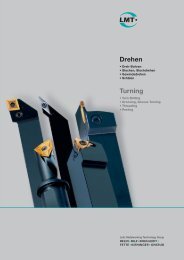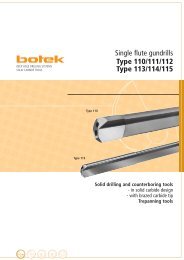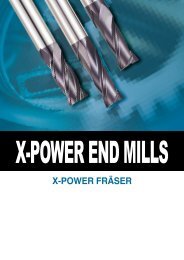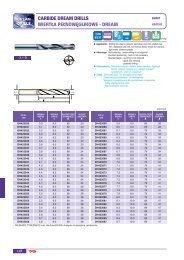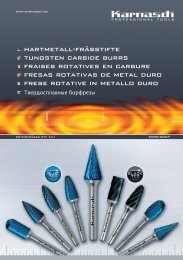Gear Cutting Tools
Hobs - Torion
Hobs - Torion
- No tags were found...
Create successful ePaper yourself
Turn your PDF publications into a flip-book with our unique Google optimized e-Paper software.
left-hand start machines a gear<br />
with right-handed teeth. This computational<br />
consideration of chip<br />
forming geometry confirmed what<br />
Thämer (1) had already found in<br />
his studies. Flank wear takes place<br />
precisely at those transitions from<br />
tool tooth tip to tool flank which<br />
are no longer actively participating<br />
in the metal cutting process. He<br />
states: "In this case the tool<br />
cutting edge which just at this corner<br />
no longer removes a chip exhibits<br />
particularly large wear mark<br />
widths, which in turn makes it<br />
clear that no direct connection exists<br />
between chip thickness and<br />
tool wear."<br />
The plotter images produced by<br />
Sulzer's method (9 and 10) confirm<br />
this assumption. Sulzer's studies<br />
covered mainly the wear behaviour<br />
of carbide hobs. Instead of flank<br />
wear, he found micro-chipping in<br />
this area. Using the scanning electron<br />
microscope, he studied the<br />
leaving flanks for chip traces and<br />
found pressure welded deposits<br />
on the flanks. He states: (11 and<br />
12) "The different dircection of the<br />
cutting traces and of the streaks<br />
indicates that these streaks are<br />
caused by the chips being removed.<br />
They occur at those points<br />
on the tooth flank which do not<br />
come into engagement with the<br />
cutter tooth concerned, i.e. there<br />
is generally a gap between the<br />
cutting edge and this flank area."<br />
The collision between chip and<br />
workpiece flank can be explained<br />
by the chip form and the chip flow.<br />
The cutting process commences at<br />
the leaving flank near the cutter<br />
tooth tip. At this stage it can still<br />
curl freely. After that the tip area of<br />
the cutter tooth moves into engagement.<br />
Because of the complicated<br />
shape and the tight space<br />
conditions in the tooth gap the chip<br />
can no longer curl freely. It is at<br />
the end pushed by the entering<br />
flank beyond the cutting face to<br />
workpiece<br />
acc. to Sulzer, Aachen polytechnic<br />
hob<br />
5 31 2<br />
46<br />
Fig. 17: Determination of the chip forming cross-sections<br />
the other workpiece flank, where it<br />
is welded on. As a result of the<br />
cutting motion of the cutter tooth<br />
the pressure welds are separated,<br />
but are formed afresh by the flowing<br />
chip. In addition, a workpiece<br />
rotation takes place during the<br />
cutting motion. This means that<br />
the workpiece flank moves away<br />
from the leaving tool flank. It is this<br />
relative speed at which the chip is<br />
pushed from the cutting face over<br />
the cutting edge. This produces<br />
tensile forces on the cutting edge<br />
cutting planes<br />
cutting planes<br />
1<br />
1 mm<br />
3<br />
2<br />
4<br />
0,2 mm<br />
entering flank<br />
tip<br />
leaving flank<br />
A B C D<br />
6<br />
5<br />
1 mm<br />
acc. to Sulzer, Aachen polytechnic<br />
Fig. 18: Determination of the chip forming cross-sections<br />
190



